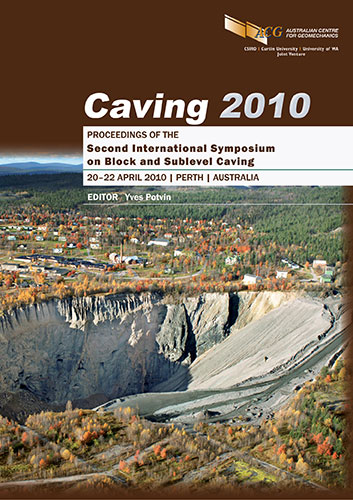The critical earthquake concept applied to block caving — evidence for cooperative behaviour during failure

|
Authors: White, H; van As, A; White, D; O'Keefe, B Paper is not available for download Contact Us |
DOI https://doi.org/10.36487/ACG_rep/1002_2_White
Cite As:
White, H, van As, A, White, D & O'Keefe, B 2010, 'The critical earthquake concept applied to block caving — evidence for cooperative behaviour during failure', in Y Potvin (ed.), Caving 2010: Proceedings of the Second International Symposium on Block and Sublevel Caving, Australian Centre for Geomechanics, Perth, pp. 83-91, https://doi.org/10.36487/ACG_rep/1002_2_White
Abstract:
Block caving is a mining method in which an orebody effectively collapses under its own weight once a sufficient area has been undercut. The ability of the rock mass to cave under its own weight is governed in large part by failure along structures within the rock mass, whether they be distinct, major faults or shears or simply microdefects in the rock fabric. Most of the associated shear failure along these structures is detected through mine microseismic monitoring systems and provides engineers with a wealth of information regarding the rock mass’ response to caving. During cave progression, the seismic response yields valuable information regarding the caving process. In particular, we have observed faster-than-exponential increases in seismic source parameters during cave propagation at Northparkes’ E26 Lift 2, suggesting that the cave is showing self-organised critical behaviour (Helmstetter and Sornette, 2002). This type of behaviour is particularly symptomatic of the caveability of geotechnical domains within the block and thus may help identify: if parts of the orebody are not in a state of criticality prior to the initiation of the cave, then it is possible that these may remain unaffected by the caving process the time dependence of the source parameters could be used to predict cave break-through changes in the deviatoric stress that are sufficient to initiate and sustain seismic activity associated with caving, thereby assisting in the design strategy for cave induction or rock mass preconditioning that will promote sustained seismicity, i.e. continuous caving.
References:
Benioff, H. (1951) Colloquium on plastic flow and deformation within the Earth, Transactions - American Geophysical Union, pp. 331–514.
Bowman, D., Ouillon, G., Sammis, C., Sornette, A. and Sornette, D. (1998) An observational test of the critical earthquake concept, Journal of Geophysical Research, Vol. 103, No. B10, pp. 24359–24372.
Cundall, P. (2008) Recent Advances in Numerical Modelling for Large-Scale Mining Projects, Australian Centre for Geomechanics Newsletter, June 2008, Vol. 30, pp. 1–7.
Grasso, J-R. and Sornette, D. (1998) Testing self-organised criticality by induced seismicity, Journal of Geophysical Research, Vol. 103, No. B12, pp. 29965–29987.
Helmstetter, A. and Sornette, D. (2002) Sub-critical and Super-critical Regimes in Epidemic Models of Earthquake Aftershocks, Journal of Geophysical Research, Vol. 107, No. B10, p. 2237.
Sornette, D. and Vanneste, C. (1992) Dynamics and memory effects in rupture of thermal fuse networks, Physical Review Letters, Vol. 68, pp. 612–615.
Sornette, D., Vanneste, C. and Knopoff, L. (1992) Statistical model of earthquake foreshocks, Physical Review – A, Vol. 45, pp. 8351–8357.
Vanneste, C. and Sornette, D. (1992) The dynamical thermal fuse model, Journal de Physique I – France 2,
pp. 1621–1644.
© Copyright 2025, Australian Centre for Geomechanics (ACG), The University of Western Australia. All rights reserved.
View copyright/legal information
Please direct any queries or error reports to repository-acg@uwa.edu.au
View copyright/legal information
Please direct any queries or error reports to repository-acg@uwa.edu.au